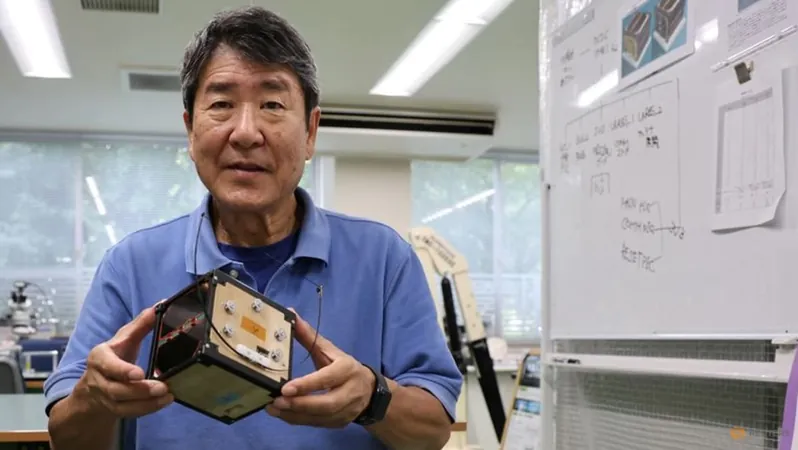
Groundbreaking Innovation: Japan Launches the World's First Wooden Satellite into Space!
2024-11-05
Author: Siti
Introduction
In a stunning leap for space exploration, Japanese researchers have successfully launched the world's first wooden satellite, LignoSat, into orbit. The groundbreaking event took place on November 5, as part of a SpaceX mission intended to transport the satellite to the International Space Station before it is released approximately 400 kilometers above Earth.
About LignoSat
LignoSat, aptly named from the Latin word for wood, is not just a remarkable feat of engineering; it serves a greater purpose. Designed by Kyoto University's visionary researchers alongside Sumitomo Forestry, this palm-sized satellite aims to showcase the potential of sustainable timber in future lunar and Martian settlements.
Significance of Timber in Space
Takao Doi, a seasoned astronaut and expert in human space activities at Kyoto University, emphasized the significance of using timber in extraterrestrial habitats. "With timber, a material we can produce sustainably, we can construct homes and establish a permanent human presence in space," he stated.
Future Vision
Looking ahead, Doi's ambitious team has laid out a 50-year vision that includes planting trees and building timber residences on the Moon and Mars. They developed this NASA-certified wooden satellite to demonstrate that wood is a viable material for space applications, which could revolutionize off-world colonization efforts.
Historical Context
Professor Koji Murata, a forest science expert at Kyoto University, pointed out the historical context of using wood in aviation. "Early 20th-century airplanes were made from wood," he noted. "If that was feasible, then a wooden satellite should definitely be possible."
Durability of Wood in Space
Interestingly, wood's durability in the harsh conditions of space is a key advantage. Because there is no water or oxygen to cause rot or combustion, wooden materials can withstand the cosmic environment better than they would on Earth. Plus, researchers argue that using wooden satellites could have a minimized environmental impact during decommissioning. Traditional metal satellites produce aluminum oxide particles when re-entering the atmosphere, whereas wooden satellites would burn up entirely, significantly reducing pollution.
Collaborations and Future Prospects
"There's a chance that metal satellites could face restrictions in the future," Doi remarked. "If we can demonstrate the efficacy of our wooden satellite, we aim to collaborate with industry leaders like Elon Musk and SpaceX."
Experimental Validation
To ensure their innovative design's effectiveness, the research team conducted an extensive 10-month experiment aboard the International Space Station, identifying honoki—a type of magnolia tree native to Japan and traditionally used for sword sheaths—as the best material for their spacecraft.
Craftsmanship of LignoSat
LignoSat is crafted using traditional Japanese woodworking techniques, completely free from screws or adhesives. Once it is deployed into orbit, LignoSat will remain for six months, during which onboard electronic components will monitor how wood endures the space environment, facing temperature extremes ranging from -100 to 100 degrees Celsius as it orbits between night and day.
Exploration of Radiation Shielding
Moreover, LignoSat will explore its unique ability to shield semiconductor components from space radiation—a feature that could have implications for data center construction on Earth and beyond, according to Kenji Kariya, a manager at Sumitomo Forestry Tsukuba Research Institute.
Conclusion
"It might appear as a throwback, but wood is indeed at the forefront of technology as we gear up for lunar and Martian habitation," Kariya concluded. "Expanding our presence into space could usher in a renaissance for the timber industry."
As humanity pushes the boundaries of exploration, this wooden satellite marks a pioneering step toward sustainable practices in space, potentially opening new chapters in our quest to conquer the cosmos. Will wooden structures become the foundation of our future space habitats? The world is watching closely!



 Brasil (PT)
Brasil (PT)
 Canada (EN)
Canada (EN)
 Chile (ES)
Chile (ES)
 España (ES)
España (ES)
 France (FR)
France (FR)
 Hong Kong (EN)
Hong Kong (EN)
 Italia (IT)
Italia (IT)
 日本 (JA)
日本 (JA)
 Magyarország (HU)
Magyarország (HU)
 Norge (NO)
Norge (NO)
 Polska (PL)
Polska (PL)
 Schweiz (DE)
Schweiz (DE)
 Singapore (EN)
Singapore (EN)
 Sverige (SV)
Sverige (SV)
 Suomi (FI)
Suomi (FI)
 Türkiye (TR)
Türkiye (TR)